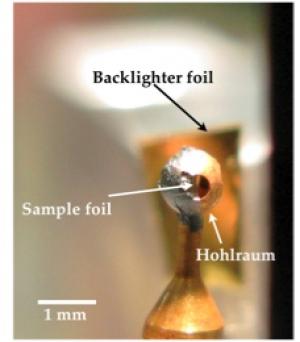Laboratoire Léon Brillouin
UMR12 CEA-CNRS, Bât. 563 CEA Saclay
91191 Gif sur Yvette Cedex, France
+33-169085241 llb-sec@cea.fr
Laboratoire Léon Brillouin
UMR12 CEA-CNRS, Bât. 563 CEA Saclay
91191 Gif sur Yvette Cedex, France
+33-169085241 llb-sec@cea.fr

Fig. 1. Example of sample, hohlraum, and backlighter foil (in the back) use for photo-absorption experiments
Collaborations : CEA/DAM/DIF , LULI/Ecole Polytechnique, CEA/DSM/IRFU/SAp
Absorption measurements in Al and ZnS in EUV range
This work has been performed at the LULI 2000 facility during the PhD thesis work of N. Kontogiannopoulos [Ecole Polytechnique, Dec. 6, 2007]. Absorption of targets is measured using gold cavities. One cavity wall is heated by the main laser beam creating a holhraum inside the cavity; in turn, holhraum heats radiatively the main target in form of a thin film put on a hole in the cavity. The probe radiation from another laser-produced plasma crosses the main target during its hydrodynamic explosion. In this experiment the objective was to study the absorption properties of a plasma mixture composed of a medium (30) and a small (16) Z element. Aluminum targets have been also investigated for comparison and for checking the cavity physics. A typical time-frequency mapping of absorption in ZnS is shown in Fig 3.
We have developed a theoretical interpretation using the superconfiguration code SCO and/or detailed term accounting code HULLAC. This allows one to identify all the main structures appearing in the ZnS spectrum. The computation of relevant complex structures such as 3d-4f in Zn6+ to Zn8+ is a serious challenge.
2p-3d absorption structures in neighboring metal plasmas: iron (Z=26), nickel (Z=28), copper (Z=29), zinc (Z=30) and germanium (Z=32)
The experiment has been performed on the LULI 2000 laser. The main new idea of the target and its atomic physics has been to use plasmas of neighbouring Z elements in order to investigate the thermal (configurational) broadening of 2p-3d transition structures. Plasma temperature has been of the order of 20 eV and density of the order of 0.01 g/cm 3. Theoretical analysis indicates that the 2p-3d spin-orbit gap should progressively show up in these spectra with increasing Z overcoming thermal broadening. We have focused our attention on the variation of the 2p-3d transition arrays with the atomic number Z in a limited range of values (Z=26, 28, 29, 30 and 32); we have then compared this Z-dependence with the influence of the plasma temperature that induces a shift and a superposition of structures, due to the thermal-configurational broadening. These studies contribute to the modelling of spin-orbit splitting and related effects such as the interaction between relativistic subconfigurations. Thus the use of different Z elements helps us to decouple inherent atomic physics of highly charged ions from thermal effects. From analysis in similar plasma conditions of plasmas with different Z, we can get information on the competition between jj and intermediate couplings. Moreover the spectral position of the 2p-3d transitions can be used as a "thermometer" since it depends on the temperature. This dependence may also reveal the presence of temperature gradients.
On Fig. 5 we present as an example the measured transmission of a radiatively heated copper plasma of 40 μg/cm2 areal density and two transmission curves calculated with the SCO code and the HULLAC code for comparison. The absorption structures near the 13 Å wavelength correspond to 2p-3d transitions. The positions of the two spin-orbit-split structures depend on temperature - the theoretical curve at the temperature 15 eV shows the best agreement with respect to the 2p-3d structures in the experimental transmission.
[1] Mesure de coefficients d'absorption de plasmas créés par laser nanoseconde
Thais F., Chenais-Popovics C., Eidmann K., Bastiani S., Blenski T., Gilleron F.
Journal de Physique IV 127, 119 (2005)
[2] Measurement of XUV-absorption spectra of ZnS radiatively heated foils
Kontogiannopoulos N., Bastiani-Ceccotti S., Thais F., Sauvan P., Schott R., Fölsner W., Arnault P., Poirier M., Blenski T.
High Energy Density Physics 3, 149 (2007)
[3] Interpretation of some X-ray and XUV absorption experiments using SCO,
Arnault P., Blenski T., Dejonghe G.
High Energy Density Physics 3, 1 (2007)
